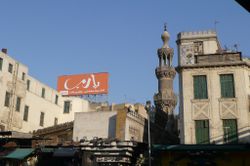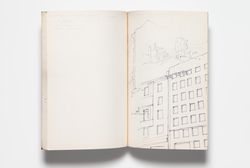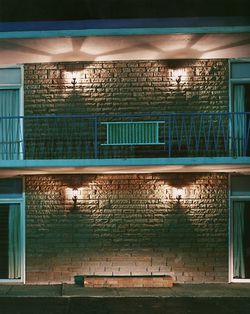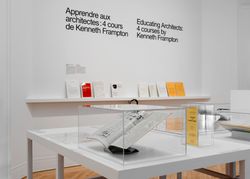textual records
AP197.S3.001
Description:
This box is comprised of personal and professional correspondence, organized in chronological order, from 1958- 1983. Correspondence documents the beginning of Frampton's professional career and includes letters from his time as: a tutor at the Royal College of Art; the technical editor of the magazine Architectural Design; a visiting professor at Princeton University; an associate professor and, subsequently, Ware Professor of the Graduate School of Architecture, Planning and Preservation; a Fellow of the Institute for Architecture and Urban Studies; and an editor of Oppositions. This correspondence includes a letter inviting Frampton to teach at Princeton University and his acceptance of the position, his appointment to the Loeb Fellowship, and his appointment as an Associate Professor at Columbia University as well as correspondence concerning the first and second editions of Modern Architecture: a critical history. Throughout this period, Frampton corresponded with various architects, professors, publishers, and editors of various publications such as: Peter Eisenman; Robert Vickery; Anthony Hill; Melvin Charney; Richard Meier; Max Bill; Panos Koulermos; Tadao Ando; Tomás Maldonado; Manfredo Tafuri; Arata Isozaki; the Casabella; Architecture and Urbanism; DOMUS; and Thames and Hudson. Activities documented in this box include: various offers of teaching positions; requests to write articles, reviews, books and recommendation letters; invitations to attend or present lectures/symposiums/conferences; and requests to serve on juries.
1958-1984
Personal and professional correspondence from 1958-1984
Actions:
AP197.S3.001
Description:
This box is comprised of personal and professional correspondence, organized in chronological order, from 1958- 1983. Correspondence documents the beginning of Frampton's professional career and includes letters from his time as: a tutor at the Royal College of Art; the technical editor of the magazine Architectural Design; a visiting professor at Princeton University; an associate professor and, subsequently, Ware Professor of the Graduate School of Architecture, Planning and Preservation; a Fellow of the Institute for Architecture and Urban Studies; and an editor of Oppositions. This correspondence includes a letter inviting Frampton to teach at Princeton University and his acceptance of the position, his appointment to the Loeb Fellowship, and his appointment as an Associate Professor at Columbia University as well as correspondence concerning the first and second editions of Modern Architecture: a critical history. Throughout this period, Frampton corresponded with various architects, professors, publishers, and editors of various publications such as: Peter Eisenman; Robert Vickery; Anthony Hill; Melvin Charney; Richard Meier; Max Bill; Panos Koulermos; Tadao Ando; Tomás Maldonado; Manfredo Tafuri; Arata Isozaki; the Casabella; Architecture and Urbanism; DOMUS; and Thames and Hudson. Activities documented in this box include: various offers of teaching positions; requests to write articles, reviews, books and recommendation letters; invitations to attend or present lectures/symposiums/conferences; and requests to serve on juries.
textual records
1958-1984
Learning from... Cairo
Nasser Rabbat challenges the traditional framing strategies of East vs. West or traditional vs. modern, focusing instead on the dialectical relationship of modernity and history in the making of contemporary Cairo. Shaped by distinct waves of modernity from the colonial Napoleonic invasion of 1789 to the revolution and independence in 1952, the city responded with layers(...)
Paul-Desmarais Theatre
15 September 2011 , 7pm
Learning from... Cairo
Actions:
Description:
Nasser Rabbat challenges the traditional framing strategies of East vs. West or traditional vs. modern, focusing instead on the dialectical relationship of modernity and history in the making of contemporary Cairo. Shaped by distinct waves of modernity from the colonial Napoleonic invasion of 1789 to the revolution and independence in 1952, the city responded with layers(...)
Paul-Desmarais Theatre
Visiting Scholar Seminar: Gregorio Carboni Maestri
Portugal: Architecture, Tendenza, Revolution
Visiting Scholar Gregorio Carboni Maestri presents his research. From the 1930s to the late 1980s, Portuguese architecture was formed through a frustrated relationship with modernity and through a crucial dialogue with Italy. This talk addresses how Portuguese architecture observed and reacted to Italian models such as rationalism in the 1930s, postwar neorealism, and(...)
Shaughnessy House Keyword(s):
Gregorio Carboni Maestri, Visiting Scholar, Portugal, Tendenza
3 August 2017, 6pm
Visiting Scholar Seminar: Gregorio Carboni Maestri
Actions:
Description:
Visiting Scholar Gregorio Carboni Maestri presents his research. From the 1930s to the late 1980s, Portuguese architecture was formed through a frustrated relationship with modernity and through a crucial dialogue with Italy. This talk addresses how Portuguese architecture observed and reacted to Italian models such as rationalism in the 1930s, postwar neorealism, and(...)
Shaughnessy House Keyword(s):
Gregorio Carboni Maestri, Visiting Scholar, Portugal, Tendenza
Architectural historian Barbara Penner traces the evolution of Niagara Falls – from its 19th-century honeymoon tourism to its state of post-industrial kitsch to its recent rebirth as a honeymoon destination. The photographer Alec Soth, whose work is the starting point for this lecture, compellingly portrays a ruined post-industrial landscape of love in his series Niagara(...)
Paul Desmarais Theatre
23 April 2009
Learning from... Niagara Falls
Actions:
Description:
Architectural historian Barbara Penner traces the evolution of Niagara Falls – from its 19th-century honeymoon tourism to its state of post-industrial kitsch to its recent rebirth as a honeymoon destination. The photographer Alec Soth, whose work is the starting point for this lecture, compellingly portrays a ruined post-industrial landscape of love in his series Niagara(...)
Paul Desmarais Theatre
Amid education reform in American schools of architecture in the 1970s, Kenneth Frampton was integral in transforming the curriculum of Columbia University’s Graduate School of Architecture Planning. In particular, he designed and taught what became three core courses: the theory seminar “Comparative Critical Analysis,” the history lectures “Thresholds of Modern(...)
31 May 2017 to 24 September 2017
Educating Architects: Four Courses by Kenneth Frampton
Actions:
Description:
Amid education reform in American schools of architecture in the 1970s, Kenneth Frampton was integral in transforming the curriculum of Columbia University’s Graduate School of Architecture Planning. In particular, he designed and taught what became three core courses: the theory seminar “Comparative Critical Analysis,” the history lectures “Thresholds of Modern(...)
archives
Level of archival description:
Collection
CD042
Synopsis:
The collection documents the research of Susan Wagg, one of the curators of the exhibition “Money Matters: A Critical Look at Bank Architecture”, on bank buildings in the United States and in Canada, from 1795 to 1979. It contains her research files on each of the bank buildings presented in the exhibition and the photograhic commission of the banks by photographers Robert Bourdeau, Edward Burtynsky, David Duchow, David Miller, Marilyn Bridges, James Iska, Len Jenshel, John Pfahl, George Tice, Catherine Wagner and Serge Hambourg.
1926-1993
Money Matters exhibition collection
Actions:
CD042
Synopsis:
The collection documents the research of Susan Wagg, one of the curators of the exhibition “Money Matters: A Critical Look at Bank Architecture”, on bank buildings in the United States and in Canada, from 1795 to 1979. It contains her research files on each of the bank buildings presented in the exhibition and the photograhic commission of the banks by photographers Robert Bourdeau, Edward Burtynsky, David Duchow, David Miller, Marilyn Bridges, James Iska, Len Jenshel, John Pfahl, George Tice, Catherine Wagner and Serge Hambourg.
archives
Level of archival description:
Collection
1926-1993
exhibitions
The terms contemplation, solitude, exile, leisure, rest, retreat, reverse, and solitude—and their antonyms action, court, world, worldliness and society—constitute a recurring chain of ideas in seventeenth-century fictional and biographical literature. From Society to Solitude combines history, literature, and architecture, focusing on the theme of the retreat and its(...)
Hall cases
12 October 1994 to 15 January 1995
From Society to Solitude: Public and Private Space in Seventeenth-Century France
Actions:
Description:
The terms contemplation, solitude, exile, leisure, rest, retreat, reverse, and solitude—and their antonyms action, court, world, worldliness and society—constitute a recurring chain of ideas in seventeenth-century fictional and biographical literature. From Society to Solitude combines history, literature, and architecture, focusing on the theme of the retreat and its(...)
exhibitions
12 October 1994 to
15 January 1995
Hall cases
archives
Level of archival description:
Fonds
Ross & Macdonald fonds
AP013
Synopsis:
The Ross & Macdonald fonds is comprised of documents concerning the work of six successive architectural firms: Ross & MacFarlane (1905-1912), Ross & Macdonald (1913-1944), Ross & Ross (1944-1946), Ross, Patterson, Townsend & Heughan (1946-1950), Ross, Patterson, Townsend & Fish (1950-1958), and Ross, Fish, Duschenes & Barrett (1958-1976). The greatest concentration of work was produced in Montreal where each of the firms maintained their head office, but there were also a large number of works executed in New Brunswick and Nova Scotia. The fonds contains 27 884 drawings (24 294 originals plus 3 590 reproductions), 236 photographs, and 18.6 metres of textual documents.
1902-1982
Ross & Macdonald fonds
Actions:
AP013
Synopsis:
The Ross & Macdonald fonds is comprised of documents concerning the work of six successive architectural firms: Ross & MacFarlane (1905-1912), Ross & Macdonald (1913-1944), Ross & Ross (1944-1946), Ross, Patterson, Townsend & Heughan (1946-1950), Ross, Patterson, Townsend & Fish (1950-1958), and Ross, Fish, Duschenes & Barrett (1958-1976). The greatest concentration of work was produced in Montreal where each of the firms maintained their head office, but there were also a large number of works executed in New Brunswick and Nova Scotia. The fonds contains 27 884 drawings (24 294 originals plus 3 590 reproductions), 236 photographs, and 18.6 metres of textual documents.
archives
Level of archival description:
Fonds
1902-1982
articles
Journeys and translation
Mrinalini Rajagopalan traces the history of the Red Fort in Delhi from its destruction by the British in 1857 to their later efforts to preserve and protect the same structure. Click here for a listing of the rest of this summer’s seminars.
Shaughnessy House
8 July 2010
Visiting Scholar Seminar: Mrinalini Rajagopalan
Actions:
Description:
Mrinalini Rajagopalan traces the history of the Red Fort in Delhi from its destruction by the British in 1857 to their later efforts to preserve and protect the same structure. Click here for a listing of the rest of this summer’s seminars.
Shaughnessy House




